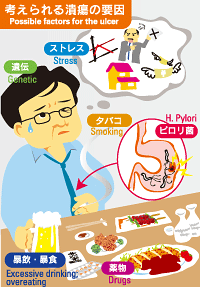
Helicobacter pylori removal
Reduce your risk factors for ulcers!
Helicobacter pylori is detected in approximately 80-90% of people with gastric and duodenal ulcers. Although it is not necessarily the only cause, eradication therapy can reduce the risk of developing the disease. In addition, more than half of people with gastric and duodenal ulcers experience a recurrence within one year.
Helicobacter pylori is also involved in the difficulty of healing ulcers and their recurrence after treatment. Eradication treatment not only prevents the recurrence of most ulcers, but also increases the risk of developing stomach cancer due to chronic stomach inflammation caused by Helicobacter pylori, so removal of Helicobacter pylori is also recommended as a means of preventing stomach cancer.

- We will give priority to those who have made reservations.
If you come to our clinic without making a reservation, your wait time may be longer depending on how busy we are, or we may refer you to another clinic.
What is Helicobacter pylori?

Helicobacter pylori (H. pylori) is a spiral-shaped bacterium that lives in the mucus of the stomach. Subsequent research has revealed that it is deeply involved in stomach diseases such as gastric ulcers. The route of infection has not been clearly elucidated, but it is thought to be mainly transmitted through the mouth during childhood.
The stomach produces strong acid (gastric acid) to digest food. It was previously thought that there were no bacteria in this gastric acid. However, the Helicobacter pylori bacteria can live in strong gastric acid. This mechanism has a negative effect on the stomach, damaging it and causing ulcers to recur. It is thought that Helicobacter pylori is transmitted orally, but the infection rate is high in developing countries, and in Japan, the infection rate is high among people born in times when sanitary conditions were not adequate, with the infection rate being said to be about 50% among people over 80 years old. However, just because someone is infected with Helicobacter pylori does not mean that they will develop ulcers or other diseases.

How to test for Helicobacter pylori
Some tests involve upper gastrointestinal endoscopy (gastroscope) and some do not.
Examination using a gastroscope
- Rapid Urease Test
- Microscopy (histopathology) is when tissue samples are examined under a microscope.
- Culture method (Microaerophilic bacterial culture is used to examine whether Helicobacter pylori grows in mucosal tissue.)
- *If you would like to undergo endoscopic examination using sedation,Notes on this pagePlease be sure to check.
Examination without using a gastroscope
- Antibody measurement (by blood or urine test)
- Urea breath test
- Stool test for detection of Helicobacter pylori antigen
Flow of Helicobacter pylori eradication
1. Inspection
We perform blood tests, urea breath tests, and endoscopic examinations to determine whether or not Helicobacter pylori is present and whether eradication is necessary.
2. Start taking the medicine
If Helicobacter pylori is confirmed and eradication is necessary, antibiotics and acid secretion inhibitors are taken twice a day, after breakfast and dinner.
Continue doing this for a week.
*If you are undergoing treatment for a gastric or duodenal ulcer, you will need to continue taking the acid secretion inhibitor for another 5 to 7 weeks.
3. Stop taking the medicine
After you stop taking the medicine, you will need to wait about four weeks to check whether the bacteria have been properly eradicated.
4. Re-examination
This will check whether H. pylori has been completely eradicated. (If any H. pylori remains, it will grow again in a few weeks.) The retest will be performed using a highly sensitive test method that can detect H. pylori.
5. Final decision
If sterilization is successful:
Your treatment is now complete. In most cases, you will not become infected again.
If complete sterilization is not possible
The type of antibiotic will be changed and the bacteria will be sterilized again.
To receive testing and treatment
How to get a medical examination
Please feel free to consult with our internal medicine department.
Medical fee
Depending on the symptoms, insurance may be applicable. (Up to the second sterilization. All treatments from the third sterilization onwards are at your own expense.)
Whether or not insurance will cover the procedure is up to the doctor's discretion, so we cannot answer in advance. Please check with your doctor during your consultation.
When receiving medical treatment covered by insurance, you will be required to pay a copayment based on your insurance points.
Private fee: Primary sterilization, secondary sterilization, tertiary sterilization (all below) 27,500 yen (tax included)
Reservation
If you would like to consult or see a specialist, please make a reservation. Internal medicinePlease come to



